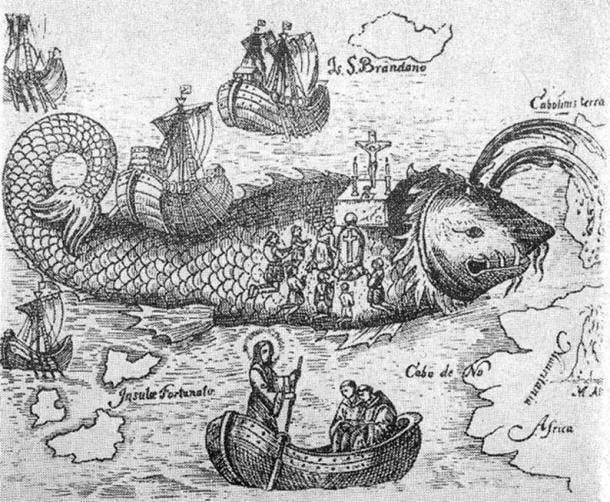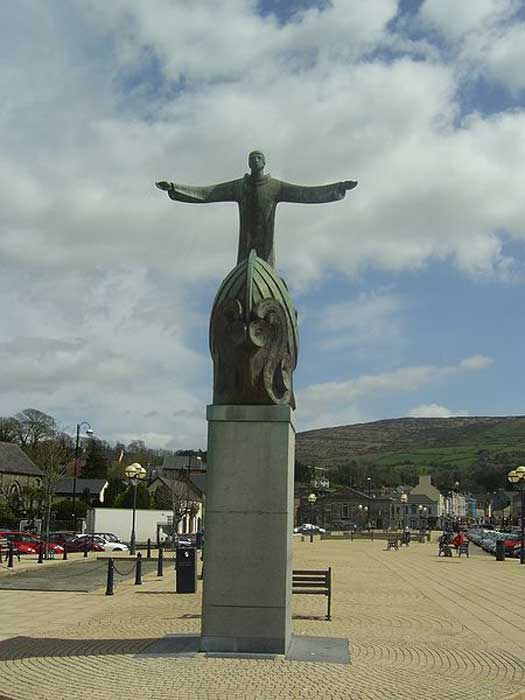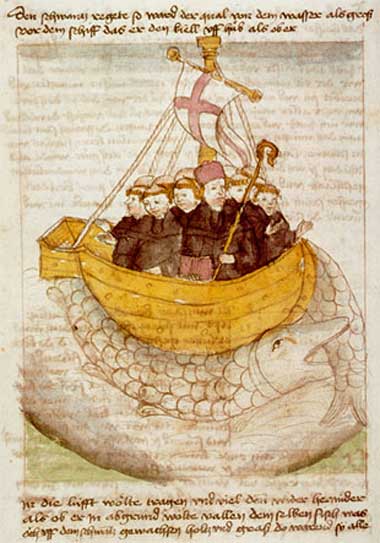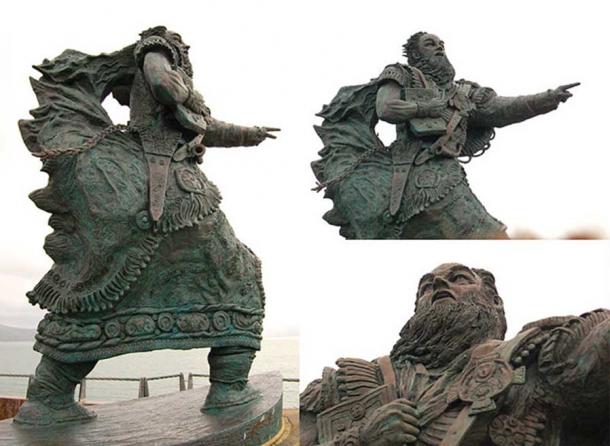
Saint Brendan and His Epic Voyage: Was the Irish Saint the First European in the New World?
Saint Brendan (also referred to by his various epithets ‘the Navigator’, ‘the Voyager’, ‘the Anchorite’, and ‘the Bold’) was an Irish saint who lived between the 5th and 6th centuries AD known for his legendary voyage in search of the ‘Island of Paradise’ or the ‘Land of Promise of the Saints’.
Part of the early Irish monastic tradition, St. Brendan traveled around northwest Europe to preach the Christian faith and to found monasteries. Whilst there is no historical proof available at present to support his famous voyage, the fantastic adventures of the saint were compiled into a piece of literary work known as the ‘ Navigatio Sancti Brendani Abbatis’ (Voyage of St. Brendan the Abbot).

A woodcut which shows the scene from Navigatio Sancti Brendani Abbatis where the saint celebrates a mass on the body of a sea monster. (Public Domain)
St. Brendan’s Ordination
St. Brendan is recorded to have been born in 484 AD, in Ciarraighe Luachra, near Tralee, a port town in the southwestern Irish county of County Kerry, which is part of the province of Munster. The records also indicate that the future saint was baptized by Saint Erc, another Irish saint, at Tubrid, near Ardfert. After a year with his parents, the child Brendan was sent to the home of a local chieftain, Airde mac Fidaigh at Cathair Airde in Listrim, about 5 km (3.11 miles) to the east of his home. At the end of his fifth year, St. Brendan returned to his family, and continued his studies under Saint Erc. In 510 AD, the saint was ordained a priest by his teacher (another source provides 512 AD as the year in which the saint was ordained).
- True Remains of the Saint Behind the Santa Myth Believed Found in Turkey
- The Immortal Count of Saint Germaine: Ascended Master of Ancient Wisdom
- Viva La Muerte! Santa Muerte, Folk Saint and Holy Personification of Death, Healer and Protector
In the following years, Saint Brendan traveled around the British Isles, spreading Christianity, and founding monastic communities. Some of the monasteries he founded included the ones at Clonfert, in County Galway (which is his largest and most celebrated), at Inis-da-druim (present day Coney Island), in County Clare, and at Shanakeel (known also as Baalynevinoorach), located at the foot of Brandon Hill in County Kerry. Additionally, St. Brendan is also remembered as a voyager thanks to the account of his fantastic voyage in search of the Island of Paradise.

Sculpture of St Brendan, The Square Bantry, County Cork. (Public Domain)
St. Brendan’s Encounter with a Sea Monster
An account of St. Brendan’s journey to the Island of Paradise may be found in a text known as the ‘ Navigatio Sancti Brendani Abbatis’, which was written down around the 9th century AD. Several variations are available, which has resulted in some differences in the details of the story. For example, St. Brendan is recorded to have not undertaken the voyage alone, but accompanied by a group of his fellow monks. The number of his companions, however, varies according to the sources, ranging from as few as 14 to as many as 60. In any case, the monks’ voyage took seven years to complete, during which they encountered a number of incredible adventures.
One of these, for example, is the monks’ encounter with the sea monster Jasconius. This tale is said to be the most commonly illustrated adventure of St. Brendan. In the tale, the monks mistake the monster as an island, due to its immense size, and went onto its back. They only realized that their island was in fact a living creature when they made their campfire, as it woke the sea monster up. In one version of the tale, the monks encountered a sea monster that sought to devour them instead. The saint prayed to God for deliverance, and another sea monster emerged from the water to slay the first monster.
- Saint Augustine of Hippo and His Detours on the Long and Winding Path to Christianity
- The Historical Count of Saint-Germaine: Elusive, Enigmatic and Eternal
- When Millions Were Dropping Dead From the Plague, The 14 Holy Helpers Were Summoned to Intercede

Saint Brendan and the whale from a 15th-century manuscript. (Public Domain)
Did Saint Brendan Reach the New World?
The voyage of Saint Brendan has led some to argue that it was this Irish saint, rather than the Vikings or Christopher Columbus, who was the first European to have reached the New World. One of the people who sought to determine the veracity of this claim was Tim Severin, a British explorer.
In 1976, Severin built a traditional ship using the design, materials, and techniques that the monks would have used. The explorer successfully sailed from Ireland to North America. Whilst this does not necessarily mean that St. Brendan was the first European to reach the New World, it does demonstrate that the voyage undertaken by the saint was entirely possible.

Statue of Brendan at Fenit Harbour. (CC BY SA 3.0)
Top image: Exhibit in the Chazen Museum of Art, University of Wisconsin-Madison, Madison, Wisconsin, USA. Source: Public Domain
By Wu Mingren
References
Anon., The Voyage of St Brendan the Abbot [Online]
[O’Donoghue, D. (trans.) 1893. The Voyage of St Brendan the Abbot.]
Available at: http://markjberry.blogs.com/StBrendan.pdf
Grattan-Flood, W. & Hartig, O., 1907. St. Brendan. [Online]
Available at: http://www.newadvent.org/cathen/02758c.htm
Haggerty, B., 2011. St. Brendan,The Navigator. [Online]
Available at: http://www.irishcultureandcustoms.com/ASaints/BrendanNav.html
Howley, A., 2013. Did St. Brendan Reach North America 500 Years Before the Vikings?. [Online]
Available at: https://voices.nationalgeographic.org/2013/05/16/did-st-brendan-reach-north-america-500-years-before-the-vikings/
Newfoundland and Labrador Heritage, 2017. Irish Monks and the Voyage of St. Brendan. [Online]
Available at: http://www.heritage.nf.ca/articles/exploration/st-brendan-voyage.php
www.saint-brendan.org, 2010. Saint Brendan The Navigator. [Online]
Available at: http://www.saint-brendan.org/index.asp
















Comments
seems there comes a time when many people so called discovered america even thousands of years ago